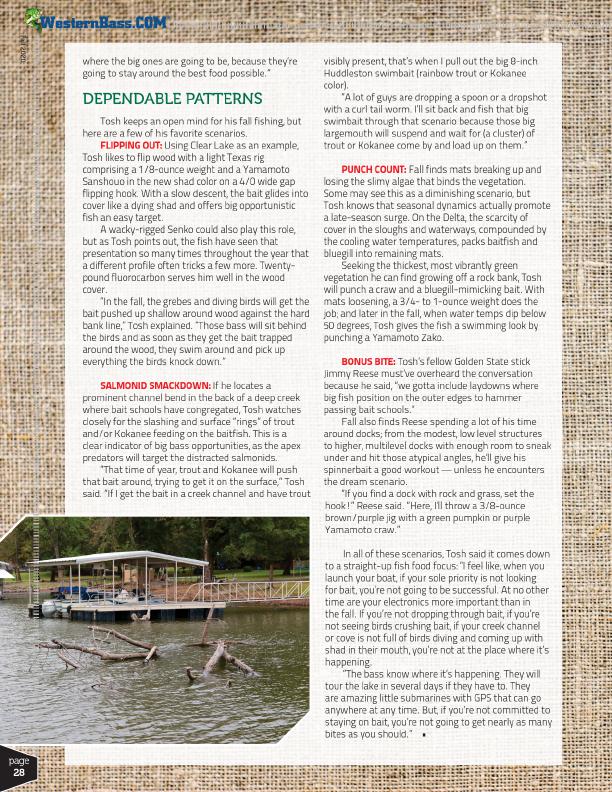
Fall 2020
page 28
®
where the big ones are going to be, because they’re going to stay around the best food possible.”
DEPENDABLE PATTERNS
Tosh keeps an open mind for his fall fishing, but here are a few of his favorite scenarios.
FLIPPING OUT: Using Clear Lake as an example, Tosh likes to flip wood with a light Texas rig comprising a 1/8-ounce weight and a Yamamoto Sanshouo in the new shad color on a 4/0 wide gap flipping hook. With a slow descent, the bait glides into cover like a dying shad and offers big opportunistic fish an easy target.
A wacky-rigged Senko could also play this role, but as Tosh points out, the fish have seen that presentation so many times throughout the year that a different profile often tricks a few more. Twenty- pound fluorocarbon serves him well in the wood cover.
“In the fall, the grebes and diving birds will get the bait pushed up shallow around wood against the hard bank line,” Tosh explained. “Those bass will sit behind the birds and as soon as they get the bait trapped around the wood, they swim around and pick up everything the birds knock down.”
SALMONID SMACKDOWN: If he locates a prominent channel bend in the back of a deep creek where bait schools have congregated, Tosh watches closely for the slashing and surface “rings” of trout and/or Kokanee feeding on the baitfish. This is a clear indicator of big bass opportunities, as the apex predators will target the distracted salmonids.
“That time of year, trout and Kokanee will push that bait around, trying to get it on the surface,” Tosh said. “If I get the bait in a creek channel and have trout
visibly present, that’s when I pull out the big 8-inch Huddleston swimbait (rainbow trout or Kokanee color).
“A lot of guys are dropping a spoon or a dropshot with a curl tail worm. I’ll sit back and fish that big swimbait through that scenario because those big largemouth will suspend and wait for (a cluster) of trout or Kokanee come by and load up on them.”
PUNCH COUNT: Fall finds mats breaking up and losing the slimy algae that binds the vegetation. Some may see this as a diminishing scenario, but Tosh knows that seasonal dynamics actually promote a late-season surge. On the Delta, the scarcity of cover in the sloughs and waterways, compounded by the cooling water temperatures, packs baitfish and bluegill into remaining mats.
Seeking the thickest, most vibrantly green vegetation he can find growing off a rock bank, Tosh will punch a craw and a bluegill-mimicking bait. With mats loosening, a 3/4- to 1-ounce weight does the job; and later in the fall, when water temps dip below 50 degrees, Tosh gives the fish a swimming look by punching a Yamamoto Zako.
BONUS BITE: Tosh’s fellow Golden State stick Jimmy Reese must’ve overheard the conversation because he said, “we gotta include laydowns where big fish position on the outer edges to hammer passing bait schools.”
Fall also finds Reese spending a lot of his time around docks; from the modest, low level structures to higher, multilevel docks with enough room to sneak under and hit those atypical angles, he’ll give his spinnerbait a good workout — unless he encounters the dream scenario.
“If you find a dock with rock and grass, set the hook!” Reese said. “Here, I’ll throw a 3/8-ounce brown/purple jig with a green pumpkin or purple Yamamoto craw.”
In all of these scenarios, Tosh said it comes down to a straight-up fish food focus: “I feel like, when you launch your boat, if your sole priority is not looking for bait, you’re not going to be successful. At no other time are your electronics more important than in the fall. If you’re not dropping through bait, if you’re not seeing birds crushing bait, if your creek channel or cove is not full of birds diving and coming up with shad in their mouth, you’re not at the place where it’s happening.
“The bass know where it’s happening. They will tour the lake in several days if they have to. They are amazing little submarines with GPS that can go anywhere at any time. But, if you’re not committed to staying on bait, you’re not going to get nearly as many bites as you should.” •